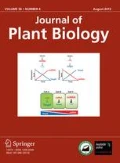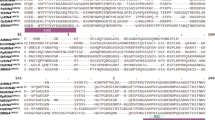Abstract
The intracellular plant resistance (R) proteins, nucleotide-binding and leucine-rich repeat (NLR) proteins, mediate resistance to pathogens by enabling recognition and rapid response. The response consists of the induction of a defensive suite that typically culminates in the hypersensitive response (HR), death of the plant cells at and around an infection site. The Arabidopsis intracellular innate immune receptor protein RESISTANCE TO PSEUDOMONAS MACULICOLA1 (RPM1) is a coiled-coil (CC) type of NLR protein that specifies resistance to strains of the bacterial pathogen Pseudomonas syringae expressing the type III effector proteins AvrRpm1 and AvrB. We previously demonstrated that RPM1-myc (an epitope-tagged version of RPM1) disappears coincident with the onset of HR induced by AvrRpm1. Infection with P. syringae expressing two other type III effector proteins, AvrRpt2 and AvrRps4, also initiated RPM1-myc disappearance at time points coincident with the HR they initiate through the NLR proteins RESISTANCE TO P. SYRINGAE2 (RPS2) and RESISTANCE TO P. SYRINGAE 4 (RPS4), respectively. Here, we use mutants impaired in NLR gene dependent signaling to demonstrate that disappearance of RPM1-myc requires normal NLR gene dependent signaling steps, but does not require HR. Inhibitors of the 26S proteasome block the disappearance of RPM1-myc and enhance RPM1-myc-dependent cell death. Our data are consistent with a model in which RPM1 is degraded by the 26S proteasome to limit the extent of RPM1-dependent signaling and/or cell death. Furthermore, AvrRpt2 induces disappearance of RPM1-myc in rps2 mutant plants without HR, suggesting that RPM1 is part of the host target of the virulence activity of AvrRpt2.




Similar content being viewed by others
References
Aarts N, Metz M, Holub E, Staskawicz BJ, Daniels MJ, Parker JE (1998) Different requirements for EDS1 and NDR1 by disease resistance genes define at least two R gene-mediated signaling pathways in Arabidopsis. Proc Natl Acad Sci USA 95:10306–10311
Austin MJ, Muskett PJ, Kahn K, Feys BJ, Jones JDG, Parker JE (2002) Regulatory role of SGT1 in early R gene-mediated plant defenses. Science 95:2077–2080
Axtell MJ, Staskawicz BJ (2003) Initiation of RPS2-specific disease resistance in Arabidopsis is coupled to the AvrRpt2-directed elimination of RIN4. Cell 16:369–377
Azevedo C, Sadanandom A, Kitigawa K, Freialdenhoven A, Shirasu K, Schulze-Lefert P (2002) The RAR1 interactor SGT1, an essential component of R gene-triggered disease resistance. Science 295:2073–2076
Azevedo C, Betsuyaku S, Peart J, Takahashi A, Noël L, Sadanandom A, Casais C, Parker J, Shirasu K (2006) Role of SGT1 in resistance protein accumulation in plant immunity. EMBO J 25:2007–2016
Bendahmane A, Kanyuka K, Baulcombe DC (1999) The Rx gene from potato controls separate virus resistance and cell death responses. Plant Cell 11:781–791
Bhandari DD, Lapin D, Kracher B, von Born P, Bautor J, Niefind K, Parker JE (2019) An EDS1 heterodimer signaling surface enforces timely reprogramming of immunity genes in Arabidopsis. Nat Commun 10:772
Bhttacharjee S, Halane MK, Kim SH, Gassman W (2011) Pathogen effectors target Arabidopsis EDS1 and alter its interactions with immune regulators. Science 334:1405–1408
Boyes DC, Nam J, Dangl JL (1998) The Arabidopsis thaliana RPM1 disease resistance gene product is a peripheral plasma membrane protein that is degraded coincident with the hypersensitive response. Proc Natl Acad Sci USA 95:15849–15854
Chen Z, Kloek AP, Boch J, Katagiri F, Kunkel BN (2000) The Pseudomonas syringae avrRpt2 gene product promotes pathogen virulence from inside plant cells. Mol Plant-Microbe Interact 13:1312–1321
Cheng YT, Li Y, Huang S, Huang Y, Dong X, Zhang Y, Li X (2011) Stability of plant immune-receptor resistance proteins is controlled by SKP1-CULLIN1-F-box (SCF)-mediated protein degradation. Proc Natl Acad Sci USA 108:14694–14699
Chern M, Canlas PE, Ronald PC (2008) Strong suppression of systemic acquired resistance in Arabidopsis by NRR is dependent on its ability to interact with NPR1 and its putative repression domain. Mol Plant 1:552–559
Clough SJ, Bent AF (1998) Floral dip: a simplified method for Agrobacterium-mediated transformation of Arabidopsis thaliana. Plant J 16:735–743
Dangl JL, Jones JDG (2001) Plant pathogens and integrated defense responses to infection. Nature 411:826–833
Dietrich RA, Delaney TP, Uknes SJ, Ward EJ, Ryals JA, Dangl JL (1994) Arabidopsis mutants simulating disease resistance response. Cell 77:565–578
Dong OX, Ao K, Xu F, Johnson KCM, Wu Y, Li L, Xia S, Liu Y, Huang Y, Rodriguez E, Chen X, Chen S, Zhang Y, Petersen M, Li X (2018) Individual components of paired typical NLR immune receptors are regulated by distinct E3 ligases. Nat Plants 4:699–710
Feys BJ, Moisan LJ, Newman MA, Parker JE (2001) Direct interaction between the Arabidopsis disease resistance signaling proteins, EDS1 and PAD4. EMBO J 20:5400–5411
Grant MR, Godiard L, Straube E, Ashfield T, Lewald J, Sattler A, Innes RW, Dangl JL (1995) Structure of the Arabidopsis RPM1 gene enabling dual specificity disease resistance. Science 269:843–846
Heidrich K, Wirthmueller L, Tasset C, Pouzet C, Deslandes L, Parker JE (2011) Arabidopsis EDS1 connects pathogen effector recognition to cell compartment-specific immune responses. Science 334:1401–1404
Holts BF III, Belkhadir Y, Dangl JL (2005) Antagonistic control of disease resistance protein stability in the plant immune system. Science 309:929–932
Hubert DA, Tornero P, Belkhadir Y, Krishna P, Takahashi A, Shirasu K, Dangl JL (2003) Cytosolic HSP90 associates with and modulates the Arabidopsis RPM1 disease resistance protein. EMBO J 22:5670–5689
Jones JDG, Dangl JL (2006) The plant immune system. Nature 444:323–329
Kadota Y, Amigues B, Ducassou L, Madaoui H, Ochsenbein F, Guerois R, Shirasu K (2008) Structural and functional analysis of SGT1-HSP90 core complex required for innate immunity in plants. EMBO Rep 9:1209–1215
Kadota Y, Shirasu K, Guerois R (2010) NLR sensors meet at the SGT1-HSP90 crossroad. Trends Biochem Sci 35:199–207
Kim HS, Desveaux D, Singer AU, Patel P, Sondek J, Dangl JL (2005) The Pseudomonas syringae effector AvrRpt2 cleaves its C-terminally acylated target, RIN4, from Arabidopsis membranes to block RPM1 activation. Proc Natl Acad Sci USA 102:6496–6501
Liu J, Elmore JM, Lin ZJ, Coaker G (2011) A receptor-like cytoplasmic kinase phosphorylates the host target RIN4, leading to the activation of a plant innate immune receptor. Cell Host Microbe 9:137–146
Mackey D, Holt BF III, Wiig A, Dangl JL (2002) RIN4 interacts with Pseudomonas syringae type III effector molecules and is required for RPM1-mediated resistance in Arabidopsis. Cell 108:743–754
Mchale L, Tan X, Koehl P, Michelmore RW (2006) Plant NBS-LRR proteins: adaptable guards. Genome Biol 7:212–222
Meyers BS, Kozik A, Griego A, Kuag H, Michelmore RW (2003) Genome-wide analysis of NBS-LRR-encoding genes in Arabidopsis. Plant Cell 15:809–834
Nimchuk Z, Marois E, Kjemtrup S, Leister RT, Katagiri F, Dangl JL (2000) Eukaryotic fatty acylation drives plasma membrane targeting and enhances function of several type III effector proteins from Pseudomonas syringae. Cell 101:353–363
Peart JR, Lui R, Sadanandom A, Malcuit I, Moffett P, Brice DC, Schauser L, Jaggard DAW, Xiao S, Coleman MJ, Dow M, Jones JDG, Shirasu K, Baulcombe DC (2002) Ubiquitin ligase-associated protein SGT1 is required for host and nonhost disease resistance in plants. Proc Natl Acad Sci USA 99:10865–10869
Redditt TJ, Chung EH, Karimi HZ, Rodibaugh N, Zhang Y, Trinidad JC, Kim JH, Zhou Q, Shen M, Dangl JL, Mackey D, Innes RW (2019) AvrRpm1 functions as an ADP-ribosyl transferase to modify NOI domain-containing proteins, including Arabidopsis and soybean RPM1-interacting protein 4. Plant Cell 31:2664–2681
Ritter C, Dangl JL (1995) The avrRpm1 gene of Pseudomonas syringae pv. maculicola is required for virulence on Arabidopsis. Mol Plant Microbe Interact 8:444–453
Ritter C, Dangl JL (1996) Interference between two specific pathogen recognition events mediated by distinct plant disease resistance genes. Plant Cell 8:251–257
Rustérucci C, Aviv DH, Holt BF III, Dangl JL, Parker JE (2001) The disease resistance signaling components EDS1 and PAD4 are essential regulators of the cell death pathway controlled by LSD1 in Arabidopsis. Plant Cell 13:2211–2224
Staskawicz BJ, Mudgett MB, Dangl JL, Galan JE (2001) Common and contrasting themes of plant and animal diseases. Science 292:2285–2289
Tornero P, Chao R, Luthin W, Goff S, Dangl JL (2002a) Large-scale structure-function analysis of the Arabidopsis RPM1 disease resistance protein. Plant Cell 14:435–450
Tornero P, Merritt P, Sadanandom A, Shirasu K, Innes RW, Dangl JL (2002b) RAR1 and NDR1 contribute quantitatively to disease resistance in Arabidopsis, and their relative contributions are dependent on the R gene assayed. Plant Cell 14:1005–1015
Wang T, Chang C, Gu C, Tang S, Xie Q, Shen QH (2016) An E3 ligase affects the NLR receptor stability and immunity to powdery mildew. Plant Physiol 172:2504–2515
Yuan X, Wang Z, Huang J, Xuan H, Gao Z (2019) Phospholipidase Dδ negatively regulates the function of resistance to Pseudomanas syringae pv. Macculicola 1 (RPM1). Front Plant Sci 9:1991
Acknowledgements
This work is a continuation of the research started in the lab of professor Dangl JL in UNC. This work was supported by the Dong-A University Research Foundation granted to Nam J.
Author information
Authors and Affiliations
Contributions
Nam J. and Mackey D. designed and performed experiments, analyzed data and wrote the manuscript. Yun DJ contributed to the interpretation of the results and the final version of the manuscript.
Corresponding author
Ethics declarations
Conflict of Interest
The authors declare that they have no conflict of interest.
Ethical Approval
The article does not contain any studies with human participants or animals performed by any of the authors.
Supplementary Information
Rights and permissions
About this article
Cite this article
Mackey, D., Yun, Dj. & Nam, J. Proteasome-Dependent Degradation of RPM1 Desensitizes the RPM1-Mediated Hypersensitive Response. J. Plant Biol. 64, 217–225 (2021). https://doi.org/10.1007/s12374-021-09296-4
Received:
Revised:
Accepted:
Published:
Issue Date:
DOI: https://doi.org/10.1007/s12374-021-09296-4





